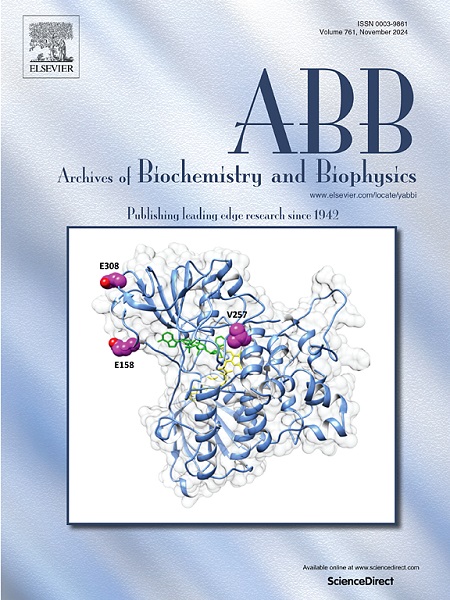Diverse β-bungarotoxin isoforms manifest different affinities to voltage-gated potassium channels of Kv1.x subfamily
IF 3.8
3区 生物学
Q2 BIOCHEMISTRY & MOLECULAR BIOLOGY
引用次数: 0
Abstract
β-Bungarotoxins (β-BuTx), consisting of covalently bound phospholipase A2 subunit (A-chain), a member of group Ia of secretory phospholipases A2, and non-enzymatic subunit (B-chain) structurally related to Kunitz-type protease inhibitors, block presynaptic neuromuscular transmission via a not completely defined mechanism of action. In vivo physiological studies revealed that the B-chain is targeting voltage-gated potassium channels of not identified subtypes. In our work, six β-BuTx isoforms were isolated from Bungarus multicinctus krait venom and characterized by mass spectrometry revealing that isoforms differ in the A- and B-chain composition. Their secondary structures determined by a circular dichroism spectroscopy were similar, while phospholipase activities differed by 1.4–2.6 times between isoforms. The β-BuTx isoforms were found to bind to the extracellular pore blocker binding site of human Kv1.1, Kv1.3 and Kv1.6 channels with submicromolar and micromolar affinities depending on the type of constituent chains. Electrophysiology data demonstrated the ability of β-BuTx isoforms to block human Kv1.3 channels with different efficiency. Though the properties of β-BuTx can depend on their subunit composition, the presented data identify human Kv1.1, Kv1.3 and Kv1.6 channels as pharmacological targets for the particular β-BuTx isoforms.

不同的β-兔毒同工型对Kv1电压门控钾通道表现出不同的亲和性。x亚科
β-Bungarotoxins (β-BuTx),由共价结合的磷脂酶A2亚基(a链)组成,是分泌磷脂酶A2的Ia族成员,与kunitz型蛋白酶抑制剂结构相关的非酶亚基(b链),通过不完全确定的作用机制阻断突触前神经肌肉传递。在体内的生理研究表明,b链是针对电压门控钾通道未确定亚型。本研究从多inctus环甲蛇毒中分离得到6个β-BuTx亚型,并通过质谱分析对其进行了鉴定,发现其A链和b链组成不同。圆二色光谱测定了它们的二级结构相似,但磷脂酶活性相差1.4 ~ 2.6倍。发现β-BuTx同工型与人类Kv1.1, Kv1.3和Kv1.6通道的细胞外孔阻滞剂结合位点具有亚微摩尔和微摩尔亲和力,这取决于组成链的类型。电生理数据表明,β-BuTx亚型能够以不同的效率阻断人类Kv1.3通道。虽然β-BuTx的性质可能取决于它们的亚基组成,但目前的数据表明,人类Kv1.1、Kv1.3和Kv1.6通道是特定β-BuTx亚型的药理学靶点。
本文章由计算机程序翻译,如有差异,请以英文原文为准。
求助全文
约1分钟内获得全文
求助全文
来源期刊

Archives of biochemistry and biophysics
生物-生化与分子生物学
CiteScore
7.40
自引率
0.00%
发文量
245
审稿时长
26 days
期刊介绍:
Archives of Biochemistry and Biophysics publishes quality original articles and reviews in the developing areas of biochemistry and biophysics.
Research Areas Include:
• Enzyme and protein structure, function, regulation. Folding, turnover, and post-translational processing
• Biological oxidations, free radical reactions, redox signaling, oxygenases, P450 reactions
• Signal transduction, receptors, membrane transport, intracellular signals. Cellular and integrated metabolism.
 求助内容:
求助内容: 应助结果提醒方式:
应助结果提醒方式:


